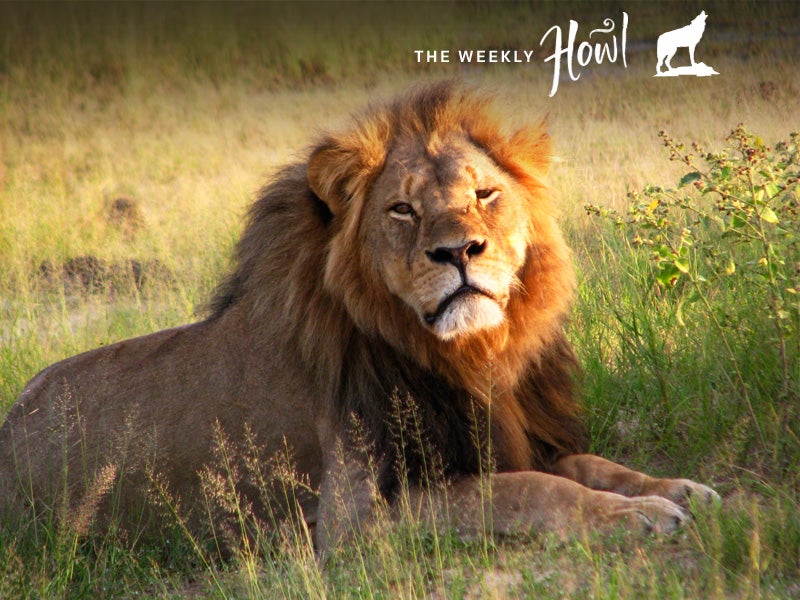From Cecil to Echo, Slaughter of Endangered Animals Stampedes On
Cecil the lion and Echo the gray wolf are just two of an untold number of protected animals killed by hunters and poachers each year.

This page was published 10 years ago. Find the latest on Earthjustice’s work.
A hunter shoots down a rare, protected apex predator sporting a radio collar for study. Claiming his actions are legal, the hunter sparks a firestorm of criticism and renewed debate about protections for imperiled species. The animal I’m talking about is Cecil the lion, lured out of the protected habitat of Hwange National Park in Zimbabwe where he was killed by Minnesota dentist Walter J. Palmer for sport.
But I’m also talking about Echo, a gray wolf who made headlines in 2014 as the first wolf spotted in the Grand Canyon area in 70 years. Schoolchildren named the three-year-old female wolf in a nationwide contest. Wolves in every state but Idaho and Montana are currently protected under the Endangered Species Act, but an unnamed hunter shot and killed Echo in February near the Fishlake National Forest in Utah. Echo’s radio collar showed she had traveled more than 750 miles before her death. While officials in Zimbabwe are calling on the U.S. to extradite Palmer on charges of poaching Cecil, the hunter who took down Echo faces no legal repercussions.
In July, the Fish and Wildlife Service opted not to charge the hunter with a crime because he said he thought he was shooting a coyote, which are legal to hunt in Utah. (Gray wolves are typically twice the size of coyotes.) Under the “McKittrick Policy”—named for a man who shot a wolf in 1995 near Yellowstone National Park but claimed he thought it was a wild dog—prosecutors have to prove a hunter knew that he or she was shooting an endangered species before bringing a case. A Fish and Wildlife Service representative told the Los Angeles Times back in 2003 that the policy effectively stops the agency from prosecuting people who kill wolves and grizzly bears in some states.
Michael Robinson of the Center for Biological Diversity says the McKittrick Policy raises the burden of proof far too high. Robinson told the Associated Press, “You can get a ‘Get out of jail free card’ by saying the magic words. Those are: ‘I thought it was coyote.’” The center has documented 13 cases since 1981 in which hunters have shot a wolf and said they believed it was a coyote.
In addition to the troubling caveats under the McKittrick Policy, protections for imperiled species are also under siege in Washington, D.C. The Endangered Species Act—our nation’s safety net for species on the verge of extinction—is supported by 90 percent of Americans. Yet political attacks on the law are at an all-time high. A new report by the Center for Biological Diversity shows that compared to the previous 15 years, Republicans in Congress have launched six times more attacks on Endangered Species Act protections since 2011, including 102 attacks targeting 228 individual species.
Members of Congress have introduced bills to block Endangered Species Act protections for certain species and geographic areas, undermine key pieces of the law, such as the ability of citizens to help enforce the act, and more. In recent years there’s also been a huge uptick in anti-Endangered Species Act “riders,” unrelated provisions attached to larger, must-pass bills. There are currently riders attached to government spending bills wending their way through Congress that target protections for gray wolves in Wyoming and the Midwest, sage grouse, the northern long-eared bat, the Sonoran desert tortoise, the lesser prairie chicken, Preble’s meadow jumping mouse and six types of mussels.
Earthjustice has been fighting to preserve the Endangered Species Act for decades, winning important cases on behalf of gray wolves, wolverines, American pika, coho salmon and Delta smelt. Want to do your part? Ask your members of Congress to fight back against legislation that would weaken the Endangered Species Act and put more imperiled animals in sport hunters’ sites.
About this series
2015 marks the 20th anniversary of the reintroduction of gray wolves to the northern Rockies, and since that time wolves have been under nearly constant threat of losing their protections. The Weekly Howl provides insights and education about the gray wolf and updates on the status of its protections while celebrating the iconic species as a vital part of a functioning, healthy ecosystem. Posts will appear every Wednesday starting June 17 and running through the summer.
Don’t miss last week’s post: “Why Do Wolves Howl? Decoding the Language of Lupines.”